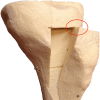A New Technique for Distalization of the Tibial Tubercle That Allows Preservation of the Proximal Buttress
- PMID: 30263901
- PMCID: PMC6156213
- DOI: 10.1177/2325967118798621
A New Technique for Distalization of the Tibial Tubercle That Allows Preservation of the Proximal Buttress
Abstract
Background: Tibial tubercle osteotomy (TTO) is a treatment option for patients with patellofemoral instability and chondrosis. Occasionally, these patients also present with patella alta, and distalization of the tibial tubercle is desirable. Free distal transfer of the tubercle, however, can compromise mechanical stability of the osteotomy construct, leading to loss of fixation.
Purpose: To evaluate alternative TTO proximal cut geometries to investigate whether these can result in tubercle distalization while preserving the proximal buttress.
Study design: Descriptive laboratory study.
Methods: Three variants of TTO cut geometry were evaluated on Sawbones as well as cadaveric knees. The proximal cut of the osteotomy was modified in 2 axes: anterior-posterior (AP) and medial-lateral (ML). Three variations were used: ML neutral/AP neutral, ML 30° proximal/AP neutral, and ML neutral/AP 30° proximal. The medial cut plane was 45° for all specimens. Tibial tubercle position was evaluated before and after osteotomy to calculate anteriorization, medialization, and distalization.
Results: Distalization was achieved with all variants. Increasing the inclination angle of the proximal cut in the AP and ML axes resulted in maximum distalization. A proximally directed cut yielded significantly more distalization when performed in the AP axis than in the ML axis (P < .05). Even the standard, neutral cut resulted in 5 mm of distalization.
Conclusion: Fulkerson osteotomy allows 3-dimensional repositioning of the tibial tubercle and has historically been utilized to achieve anteriorization and medialization. Even the neutral cut of a standard TTO resulted in distalization, which is relevant for patients with preexisting patella baja. Modification of the proximal cut increased distalization of the tubercle while preserving the proximal buttress, a potential benefit for construct stability.
Clinical relevance: These results provide a guideline for adjusting the proximal cut geometry in Fulkerson TTO to meet specific patient needs.
Keywords: knee injury; osteotomy; patellofemoral joint; patellofemoral syndrome.
Conflict of interest statement
The authors declared that they have no conflicts of interest in the authorship and publication of this contribution. AOSSM checks author disclosures against the Open Payments Database (OPD). AOSSM has not conducted an independent investigation on the OPD and disclaims any liability or responsibility relating thereto.
Figures




References
-
- Balcarek P, Oberthür S, Hopfensitz S, et al. Which patellae are likely to redislocate? Knee Surg Sports Traumatol Arthrosc. 2013;22(10):2308–2314. - PubMed
-
- Dejour H, Walch G, Nove-Josserand L, Guier C. Factors of patellar instability: an anatomic radiographic study. Knee Surg Sports Traumatol Arthrosc. 1994;2(1):19–26. - PubMed
-
- Fulkerson JP. Anteromedialization of the tibial tuberosity for patellofemoral malalignment. Clin Orthop Relat Res. 1983;(177):176–181. - PubMed
-
- Hall MJ, Mandalia VI. Tibial tubercle osteotomy for patello-femoral joint disorders. Knee Surg Sports Traumatol Arthrosc. 2016;24(3):855–861. - PubMed
LinkOut - more resources
Full Text Sources
Other Literature Sources
Medical

